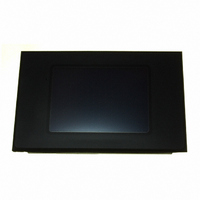20-101-0303 Rabbit Semiconductor, 20-101-0303 Datasheet - Page 90

20-101-0303
Manufacturer Part Number
20-101-0303
Description
SMARTSCREEN OP7100 W/TOUCHSCREEN
Manufacturer
Rabbit Semiconductor
Datasheet
1.101-0303.pdf
(126 pages)
Specifications of 20-101-0303
Display Type
STN - Super-Twisted Nematic
Viewing Area
121.00mm L x 91.00mm W
Backlight
CCFL - White
Dot Pitch
0.36mm x 0.36mm
Dot Pixels
320 x 240 (QVGA)
Interface
Serial
Product
Prototyping Accessories
Processor Type
Z180
Sram
128 KB
Flash
512 KB
Number Of I/os
16
Backup Battery
3 V Lithium Coin Type
Operating Voltage
10 V to 30 V
Power Consumption
4.5 W
Interface Type
Ethernet
Lead Free Status / RoHS Status
Lead free / RoHS Compliant
Display Mode
-
Dot Size
-
Lead Free Status / Rohs Status
Lead free / RoHS Compliant
Other names
20-101-0303
20-101-303
20-101-303
316-1175
20-101-303
20-101-303
316-1175
- Current page: 90 of 126
- Download datasheet (780Kb)
90
Out of the Box
Check the items mentioned in this section before starting development.
• Verify that the OP7100 runs in standalone mode before connecting any
• Verify that the entire host system has good, low-impedance, separate
• Do not connect analog ground to digital ground anywhere.
• Double-check the connecting ribbon cables to ensure that all wires go
• Verify that the host PC’s COM port works by connecting a good serial
• Use the supplied Rabbit Semiconductor power supply. If another power
• Use the supplied Rabbit Semiconductor cables. The most common fault
• Experiment with each peripheral device connected to the OP7100 to
• The frame ground and 0 V are connected internally via a jumper on
devices.
grounds for analog and digital signals. The OP7100 might be connected
between the host PC and another device. Any differences in ground
potential from unit to unit can cause serious problems that are hard to
diagnose.
to the correct screw terminals on the OP7100.
device to the COM port. Remember that COM1/COM3 and COM2/
COM4 share interrupts on a PC. User shells and mouse drivers, in
particular, often interfere with proper COM port operation. For
example, a mouse running on COM1 can preclude running Dynamic C
on COM3.
supply must be used, verify that it has enough capacity and filtering to
support the OP7100.
of user-made cables is failure to properly assert CTS. Without CTS
being asserted, theOP7100’s RS-232 port will not transmit. Assert CTS
by either connecting the RTS signal of the PC’s COM port or looping
back the OP7100’s RTS.
determine how it appears to the OP7100 when powered up, powered
down, and/or when its connecting wiring is open or shorted.
header JP5. Remove the jumper if this connection causes problems or
is otherwise not required.
Troubleshooting
OP7100
Related parts for 20-101-0303
Image
Part Number
Description
Manufacturer
Datasheet
Request
R

Part Number:
Description:
COMPUTER SGL-BRD BL2500 29.4MHZ
Manufacturer:
Rabbit Semiconductor
Datasheet:

Part Number:
Description:
COMPUTER SGL-BRD BL2500 29.4MHZ
Manufacturer:
Rabbit Semiconductor
Datasheet:

Part Number:
Description:
DISPLAY GRAPHIC 12KEY PROG OP670
Manufacturer:
Rabbit Semiconductor
Datasheet:

Part Number:
Description:
DISPLAY GRAPHIC 12KEY ETH OP6700
Manufacturer:
Rabbit Semiconductor
Datasheet:

Part Number:
Description:
COMPUTER SINGLE-BOARD BL2030
Manufacturer:
Rabbit Semiconductor

Part Number:
Description:
COMPUTER SGL-BOARD ETH BL2010
Manufacturer:
Rabbit Semiconductor

Part Number:
Description:
MODULE OP6810 W/O ETH/MEM EXPANS
Manufacturer:
Rabbit Semiconductor
Datasheet:

Part Number:
Description:
COMPUTER SINGLE-BOARD BL2020
Manufacturer:
Rabbit Semiconductor

Part Number:
Description:
COMPUTER BL2010 W/FRICTION LOCK
Manufacturer:
Rabbit Semiconductor

Part Number:
Description:
COMPUTER BL2020 W/FRICTION LOCK
Manufacturer:
Rabbit Semiconductor

Part Number:
Description:
COMPUTER SGL-BRD BL2500 44.2MHZ
Manufacturer:
Rabbit Semiconductor
Datasheet:

Part Number:
Description:
COMPUTER SGL-BOARD FULL BL2000
Manufacturer:
Rabbit Semiconductor

Part Number:
Description:
COMPUTER SINGLE-BOARD BL2110
Manufacturer:
Rabbit Semiconductor

Part Number:
Description:
COMPUTER SGL-BRD 29.4MHZ BL2610
Manufacturer:
Rabbit Semiconductor
Datasheet:

Part Number:
Description:
INTERFACE OP6800 512K FLASH&SRAM
Manufacturer:
Rabbit Semiconductor
Datasheet:










